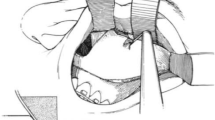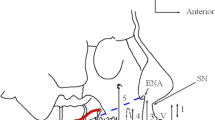Abstract
Introduction
The purpose of this study is to demonstrate the surgical technique for the correction of midfacial deformities; vertical excess and posteroanterior hypoplasia. This situation obligates the need to move the whole osseous structure in an oblique posteroanterior movement that should correct both midfacial deformities. This should also correct the lip incompetence while improving the malar projection on a profile view of the patient. We also present a mathematical formula that gives the angulation needed for moving the midface complex in a simultaneous vertical and posteroanterior direction. Once given the correct angulation for the desired oblique movement, the surgeon can reproduce this angulation with custom made surgical guides over the stereolithographic model, that can then be used during surgery to achieve the desired movement accurately. This technique exemplified on this paper will give maxillofacial surgeons a new and affordable tool for the correction of midfacial deformities in an accurate and easily reproducible manner and amplifying the surgical repertoire.
Materials and Methods
Patients seen in the specialty hospital “Dr. Bernardo Sepulveda” National Medical Center XXI Century, IMSS, during the period from February 2013 to November 2014 with Modified Oblique Le Fort III osteotomies, with the application of two trigonometric formulas for the accuracy of the technique.
Conclusions
The application of the formulas give accurate results as well as the enlargement of the upper airway and esthetic results.


















































Similar content being viewed by others
References
Gateno J, Teichgraeber JF, Xia JJ (2003) Three-dimensional surgical planning for maxillary and midface distraction osteogenesis. J Craniofac Surg 14(6):833–839
Pai L, Kohout MP, Mulliken JB (1999) Prospective anthropometric analysis of sagittal orbital-globe relationship following frontoorbital advancement in childhood. Plast Reconstr Surg 103:1341–1346
Gateno J, Xia JJ, Teichgraeber JF et al (2007) Clinical feasibility of computer-aided surgical simulation (CASS) in the treatment of complex cranio-maxillofacial deformities. J Oral Maxillofac Surg 65:728
Xia JJ, Gateno J, Teichgraeber JF (2009) New clinical protocol to evaluate craniomaxillofacial deformity and plan surgical correction. J Oral Maxillofac Surg 67:2093–2106
Gateno J, Forrest KK, Camp B (2001) A comparison of 3 methods of face-bow transfer recording: implications for orthognathic surgery. J Oral Maxillofac Surg 59:635
Troulis MJ, Everett P, Seldin EB et al (2002) Development of a three-dimensional treatment planning system based on computed tomographic data. Int J Oral Maxillofac Surg 31:349
Ellis E III, Tharanon W, Gambrell K (1992) Accuracy of face-bow transfer: effect on surgical prediction and postsurgical result. J Oral Maxillofac Surg 50:562
Severt TR, Proffit WR (1997) The prevalence of facial asymmetry in the dentofacial deformities population at the University of North Carolina. Int J Adult Orthodon Orthognath Surg 12:171
Swennen GR, Schutyser F (2006) Three-dimensional cephalometry: spiral multi-slice vs cone-beam computed tomography. Am J Orthod Dentofacial Orthop 130:410
Bell WH (1992) Modern practice in orthognathic and reconstructive surgery, vol 1. W.B. Saunders, Philadelphia
Proffit WR, White RP Jr, Sarver DM (2003) Contemporary treatment of dentofacial deformity. Mosby, St. Louis
Xia JJ, Shevchenko L, Gateno J, Teichgraeber JF, Taylor TD, Lasky RE, English JD, Hau CH, McGrory KR (2011) Outcome study of computer-aided surgical simulation in the treatment of patients with craniomaxillofacial deformities. J Oral Maxillofac Surg 69:2014–2024
Hsu SS-P, Gateno J, Bell RB, Hirsch DL, Markiewicz MR, Teichgraeber JF, Zhou X, Xia JJ (2013) Accuracy of a computer-aided surgical simulation protocol for orthognathic surgery: a prospective multicenter study. J Oral Maxillofac Surg 71:128–142
Epker BN, Stella JP, Fish LC (1995) Dentofacial deformities: integrated orthodontic and surgical correction, vol 1. Mosby, St. Louis
Obwegeser HL (2001) Mandibular growth anomalies. Springer, Berlin
Miloro M (2004) Peterson’s principles of oral and maxillofacial surgery. BC Decker, Hamilton
Ettorre G, Weber M, Schaaf H, Lowry JC, Mommaerts MY, Howaldt HP (2006) Standards for digital photography in craniomaxillo-facial surgery—part I: basic views and guidelines. J Craniomaxillofac Surg 34:65–73
Schaaf H, Streckbein P, Ettorre G, Lowry JC, Mommaerts MY, Howaldt HP (2006) Standards for digital photography in craniomaxillo-facial surgery—part II: additional picture sets and avoiding common mistakes. J Craniomaxillofac Surg 34:366–377
Bell WH, Proffit WR, White RP (1980) Surgical correction of dentofacial deformities. W.B. Saunders, Philadelphia
García y Sánchez JM, Gómez Rodríguez CL, Romero Flores J (2015) Surgical guides for modified oblique Le Fort III osteotomy. J Maxillofac Oral Surg. doi:10.1007/s12663-014-0620-1
Garcia y Sanchez JM (1992) Oblique modified Le Fort III osteotomy. Chapter 50: modern practice in orthognathic and reconstructive surgery, vol 3. W.B. Saunders, Philadelphia
Ellis E III, Zide MF (2006) Surgical approaches to the facial skeleton, 2nd edn. Lippincott Williams & Wilkins, Philadelphia
Communicación Personal, Ingeniero Francisco Javier Sanchez Murguiondo UNAM
Author information
Authors and Affiliations
Corresponding author
Rights and permissions
About this article
Cite this article
García y Sánchez, J.M., Romero Flores, J., Gómez Rodríguez, C.L. et al. “Modified Oblique Le Fort III Osteotomy” New Concepts. J. Maxillofac. Oral Surg. 16, 22–42 (2017). https://doi.org/10.1007/s12663-016-0893-7
Received:
Accepted:
Published:
Issue Date:
DOI: https://doi.org/10.1007/s12663-016-0893-7




